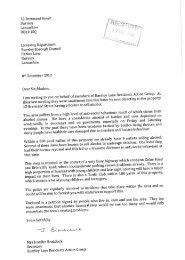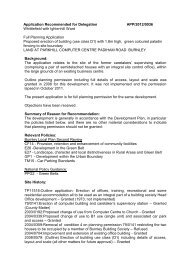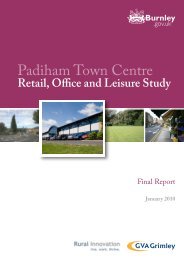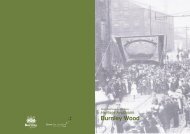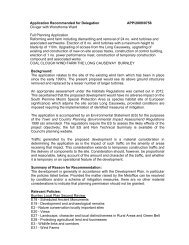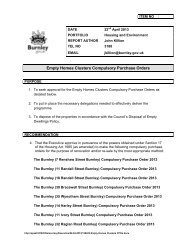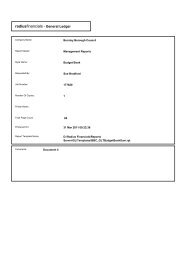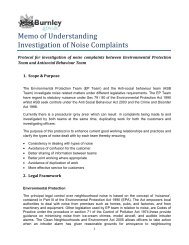The Padiham Heritage Appraisal - Burnley Borough Council
The Padiham Heritage Appraisal - Burnley Borough Council
The Padiham Heritage Appraisal - Burnley Borough Council
- No tags were found...
You also want an ePaper? Increase the reach of your titles
YUMPU automatically turns print PDFs into web optimized ePapers that Google loves.
Number 46 Ingham Street was originally part of aplan for 23 houses and 1 shop submitted by MessrsLancaster, Wilkinson and Holland in 1879. It wasoccupied by William Marsden, greengrocer, in 1887and remained in commercial use until recently (Barrett,1887, 244). Elements of the shop front, notably thewindow opening, have been retained.George Hargreaves, grocer/ tea dealer, was listed at25 High Street in 1879 (Barrett, 1879, 186). Today thebuilding has been converted into residential use, butthe ground floor shop window openings are a reminderof the building’s past use.A stone plaque commemorating the coronation of KingEdward VII on 26-28 Grove Lane reads ‘P.I.C.S. LTDCoronation Buildings 1902’ (<strong>Padiham</strong> IndependentCooperative Society). Although planning permissionwas granted for change of use from commercial toresidential in 2000 parts of the original shop front havebeen retained.5.5.4 <strong>The</strong> only other commercial business in Area 3 is the Somerfield supermarket, whichwas built on the junction of <strong>Burnley</strong> Road/ Waddington Street during the 20th century. OrchardMill built in 1852-3 by John and Charles Waddington once occupied this site overlooking theRiver Calder. <strong>The</strong> only evidence of this mill today is part of its stone boundary wall along WyreStreet.5.6 Schools5.6.1 <strong>The</strong> first school in Partridge Hill was an infants school which originated in 1858 underthe direction of Sir James Kay Shuttleworth. He later provided a girls department in 1870together with a schoolhouse and later a boys department in 1871. <strong>The</strong> school known as St.Matthews in the 1870’s became associated with St. Matthew’s Church, which was also builtat that time, although it accepted children from all denominationalbackgrounds (Haines & Jones, 2006, pers. comm & 5.7.1). Althoughthe school closed and was cleared during the mid 20th century, thelocally listed stone schoolhouse and stone perimeter school wallremain today (Plan F). <strong>The</strong> schoolhouse has a stone plaque, whichreads School House 1870.Sarah Brown and Elizabeth Holmes were bothrecorded as lodgers and schoolmistresses livingat this schoolhouse in 1871 and teaching at St.Matthew’s in 1872 (1871 Census & Worrell 1872,195).5.6.2 An infants’ school, run by Isobella Taylor was located withinone of the terraced properties on ‘Mitton Street’ in 1868, but tradedirectories suggested that it did not operate for very long (Mannex,1868, p 821 and Plan C). Mytton Street was cleared during the mid20th century and the sloping site has now been simply landscapedwith grass and trees.5.6.3 By the late 19th century, there was also a private school/academy for a short time located within 17 Grove Place where itsproprietor John Cocks possibly taught shorthand and bookkeeping(Barrett, 1887, 238). He was recorded as a schoolteacher andmathematician living next door at number 19 in 1891(Census 1891).Today this mid terraced property has reverted back to residentialuse and it is difficult to imagine that part of it was formerly used as aschool.5.6.4 After the Education Act of 1870, the church and chapelauthorities in the town built three new schools in <strong>Padiham</strong> in the early1870s, thereby removing the need for any new state or secular schoolsto be provided under the new legislation (Haines & Jones, 2006, pers.comm ).John S. Cocks’ school/academy was located within17 Grove Place in 1887 (Bennett, 1887, p.238)50 heritage appraisal



